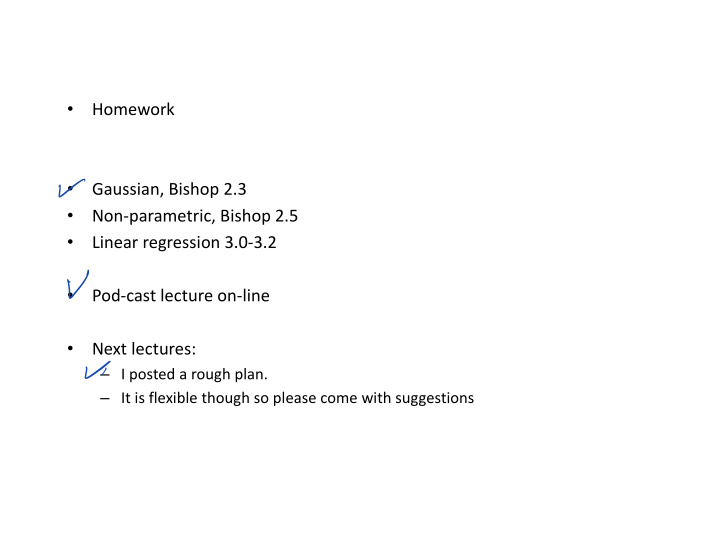



• Homework Gaussian, Bishop 2.3 • Non-parametric, Bishop 2.5 • Linear regression 3.0-3.2 • Pod-cast lecture on-line • Next lectures: • – I posted a rough plan. – It is flexible though so please come with suggestions
Bayes for linear model ! = #$ + & &~N(*, , & ) y ~N(#$, , & ) prior: $~N(*, , $ ) $ 0 = , 1 # 2 , 3 45 ! . $ ! ~. ! $ . $ ~/ $ 0 , , . mean , 1 = # 2 , 3 45 # + , 3 45 0
Bayes’ Theorem for Gaussian Variables • Given we have • where •
Sequential Estimation Contribution of the N th data point, x N correction given x N correction weight old estimate
Bayesian Inference for the Gaussian Bishop2.3.6 Assume s 2 is known. Given i.i.d. data the likelihood function for µ is given by This has a Gaussian shape as a function of µ (but it is not a distribution • over µ ).
Bayesian Inference for the Gaussian Bishop2.3.6 Combined with a Gaussian prior over µ , • this gives the posterior •
Bayesian Inference for the Gaussian (3) • Example: for N = 0, 1, 2 and 10. Prior
Bayesian Inference for the Gaussian (4) Sequential Estimation The posterior obtained after observing N-1 data points becomes the prior when we observe the N th data point. Conjugate prior: posterior and prior are in the same family. The prior is called a conjugate prior for the likelihood function.
Nonparametric Methods (1) Bishop 2.5 • Parametric distribution models (… Gaussian) are restricted to specific forms, which may not always be suitable; for example, consider modelling a multimodal distribution with a single, unimodal model. • Nonparametric approaches make few assumptions about the overall shape of the distribution being modelled. • 1000 parameters versus 10 parameters • Nonparametric models (not histograms) requires storing and computing with the entire data set. • Parametric models, once fitted, are much more efficient in terms of storage and computation.
Nonparametric Methods (2) Histogram methods partition the data space into distinct bins with widths ¢ i and count the number of observations, n i , in each bin. Often, the same width is used for all • bins, D i = D . D acts as a smoothing parameter. • In a D-dimensional space, using M bins • in each dimension will require M D bins! => it only work for marginals.
Nonparametric Methods (3) If the volume of R, V, is sufficiently • Assume observations drawn from a small, p(x) is approximately density p(x) and consider a small region R constant over R and containing x such that Thus • The probability that K out of N observations lie inside R is Bin(KjN,P ) and if N is large V small, yet K>0, therefore N large?
Nonparametric Methods (4) Kernel Density Estimation: fix V, estimate K from the data. Let R be a hypercube centred on x and define the kernel function (Parzen window) • It follows that and hence •
Nonparametric Methods (5) To avoid discontinuities in p(x), use a smooth kernel, e.g. a Gaussian Any kernel such that h acts as a smoother. will work.
Nonparametric Methods (6) Nearest Neighbour Density Estimation: fix K, estimate V from the data. Consider a hypersphere centred on x and let it grow to a volume, V ? , that includes K of the given N data points. Then K acts as a smoother.
K-Nearest-Neighbours for Classification (1) • Given a data set with N k data points from class C k and , we have • and correspondingly • Since , Bayes’ theorem gives K = 3 K = 1
K-Nearest-Neighbours for Classification (3) • K acts as a smother • For , the error rate of the nearest-neighbour (K=1) classifier is never more than twice the optimal error (from the true conditional class distributions).
Linear regression: Linear Basis Function Models (1) Generally where f j (x) are known as basis functions . • Typically, f 0 (x) = 1, so that w 0 acts as a bias. • Simplest case is linear basis functions: f d (x) = x d . • http://playground.tensorflow.org/
Some types of basis function in 1-D Sigmoids Gaussians Polynomials Sigmoid and Gaussian basis functions can also be used in multilayer neural networks, but neural networks learn the parameters of the basis functions. This is more powerful but also harder and messier.
Two types of linear model that are equivalent with respect to learning bias T = + + + = y ( x, w ) w w x w x ... w x 0 1 1 2 2 T = + f + f + = F y ( x, w ) w w ( x ) w ( x ) ... w ( x ) 0 1 1 2 2 • The first and second model has the same number of adaptive coefficients as the number of basis functions +1. • Once we have replaced the data by basis functions outputs, fitting the second model is exactly the same the first model. – No need to clutter math with basis functions
Maximum Likelihood and Least Squares (1) • Assume observations from a deterministic function with added Gaussian noise: where • or, • Given observed inputs, , and targets , we obtain the likelihood function
Maximum Likelihood and Least Squares (2) Taking the logarithm, we get Where the sum-of-squares error is
Maximum Likelihood and Least Squares (3) Computing the gradient and setting it to zero yields Solving for w, The Moore-Penrose where pseudo-inverse, .
Maximum Likelihood and Least Squares (4) Maximizing with respect to the bias, w 0 , alone, We can also maximize with respect to b , giving
Geometry of Least Squares Consider N-dimensional M-dimensional S is spanned by w ML minimizes the distance between t and its orthogonal projection on S, i.e. y.
Recommend
More recommend